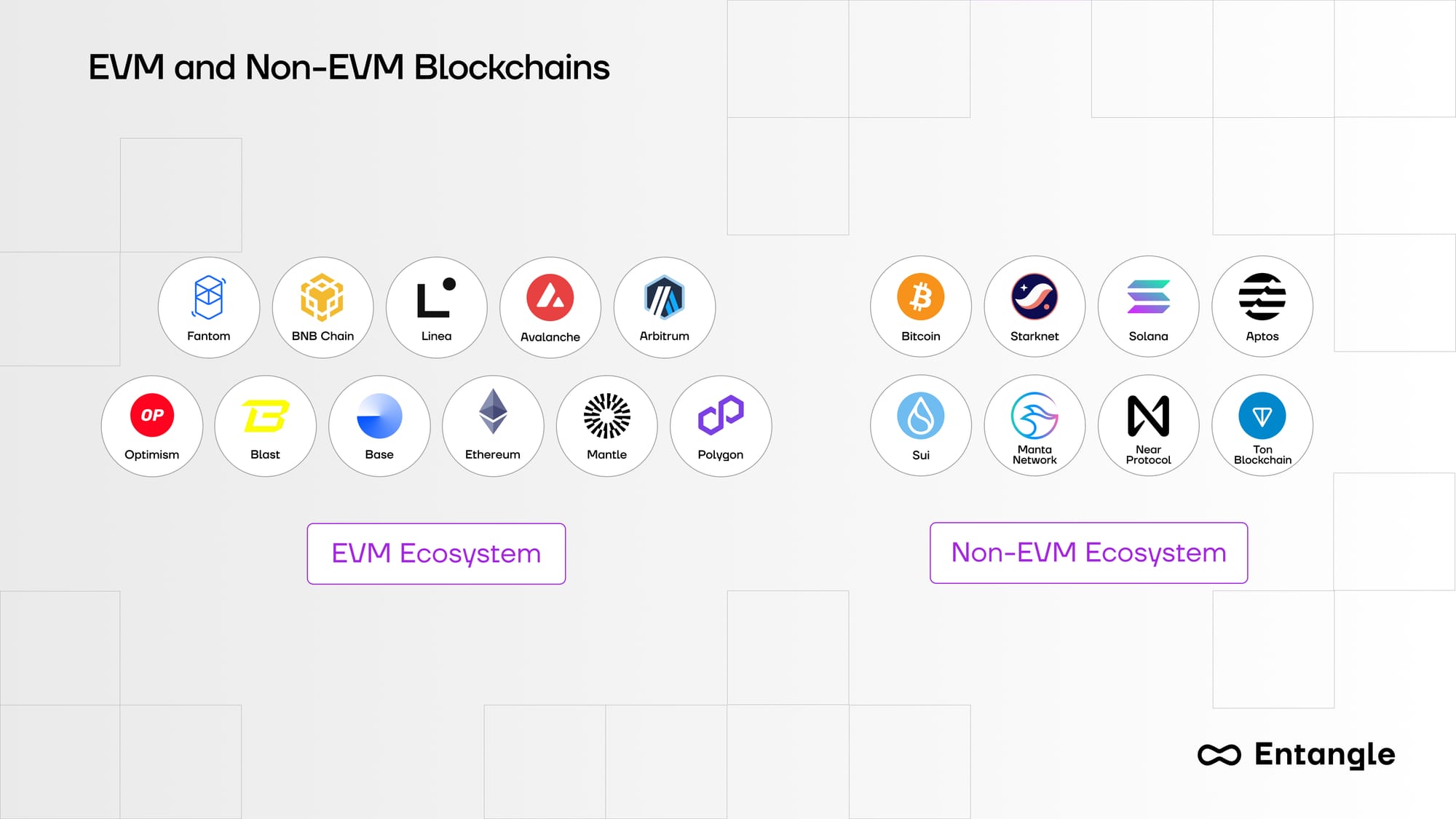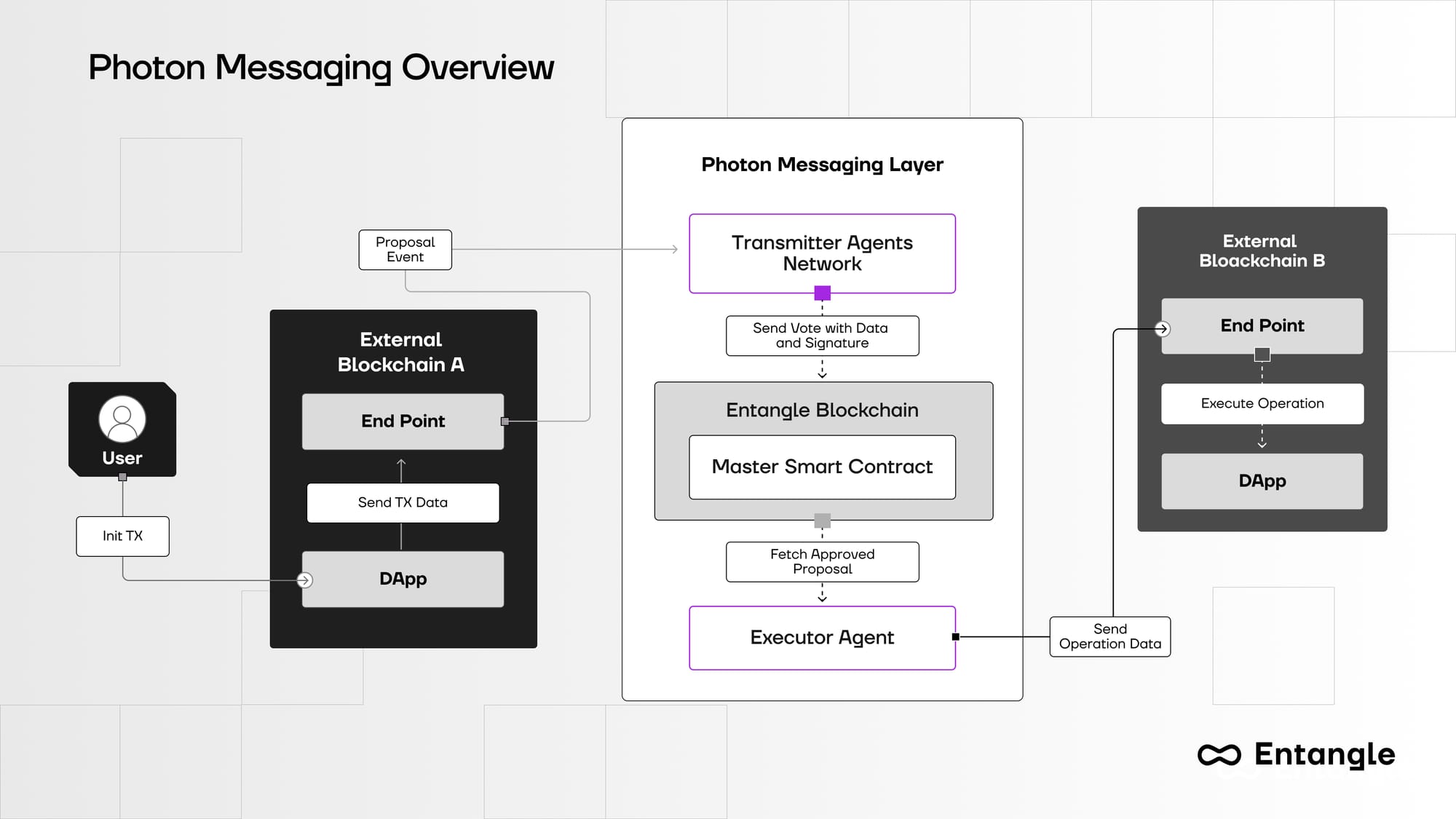EVM vs Non-EVM: New Environments, New Opportunities
Learn about the differences between EVM and non-EVM chains.

Ethereum changed the game by introducing smart contracts, empowering developers to build decentralized applications (dApps). Central to this is the Ethereum Virtual Machine (EVM), which ensures that smart contracts execute securely and in isolation. Following Ethereum's lead, several blockchain networks like BNB Smart Chain (BSC), Polygon, Tron, and more, have adopted the EVM, becoming “EVM-compatible” chains.
However, not all blockchain networks are EVM-compatible. This distinction between EVM and non-EVM blockchains is crucial as it impacts the development, deployment, and interoperability of smart contracts.
In this blog, we will explore the differences between EVM and non-EVM chains. We will also discuss how Entangle’s Photon Messaging enables interoperability between these two ecosystems and the use cases it unlocks.

What is EVM?
The Ethereum Virtual Machine is a powerful, Turing-complete software that serves as the runtime environment for smart contracts on the Ethereum blockchain. It executes bytecode instructions compiled from high-level programming languages like Solidity and Vyper, determining the blockchain's state for each new block. Each line of code executed in the EVM has an associated gas cost, tracking execution expenses and preventing spam.
Blockchains choose to be EVM-compatible for several reasons. Firstly, it leverages a large pool of developers skilled in creating dApps for Ethereum, attracting them to new platforms without requiring them to learn new programming languages. Secondly, EVM compatibility facilitates the easy movement and interaction of applications and assets across different blockchain networks.
Lastly, Ethereum’s EVM is a time-tested platform with robust infrastructure, providing a reliable standard for other blockchains to emulate, ensuring a secure and stable environment for executing smart contracts.
What is Non-EVM?
Non-EVM blockchains are those that do not adhere to the technical standards and specifications set by the EVM. These blockchains often employ different programming languages, consensus mechanisms, and architectural designs, contributing to a more diverse blockchain ecosystem.
One of the major reasons to opt for non-EVM chains is to avoid the high gas costs associated with the EVM, especially during network congestion. In contrast, non-EVM protocols focus on optimizing performance by prioritizing scalability, speed, and lower fees. They often select virtual machine functionalities and programming languages that align with their unique philosophy and technical capabilities, such as Cardano’s use of functional languages like Haskell and Plutus to emphasize formal verification.
Achieving Interoperability Between EVM and Non-EVM Chains
EVM platforms have a significant "first-mover" advantage, with the majority of DeFi Total Value Locked (TVL) concentrated in EVM platforms like Ethereum, Tron, and BNB Smart Chain, accounting for 74.15% of overall TVL. Non-EVM apps miss out on significant liquidity and capital by not interacting with EVM platforms.
Developers are familiar with popular EVM languages like Solidity and Vyper, while non-EVM languages may require more training. Despite this, non-EVM chains offer user-friendly benefits like low gas costs and high speed. Rather than forcing a choice between ecosystems, enhancing interoperability between EVM and non-EVM chains is crucial.
Entangle’s Photon Messaging is an omnichain messaging protocol, facilitating secure and efficient communication across both EVM and non-EVM blockchains. Entangle’s Photon-powered e-Bridge is now live on EVM ecosystems such as Mantle, BASE, and BNB. Recently, Entangle expanded its presence to the non-EVM ecosystem by integrating with Solana, bridging the gap between these diverse blockchain environments.
EVM-Non-EVM Interoperability Unlocks Powerful Use Cases
Here are some powerful use cases that we can unlock with EVM-non-EVM interoperability.
- Omnichain Asset Deployment: Developers can create decentralized applications and assets that communicate across both EVM and non-EVM networks through a single deployment. This considerably reduces overhead and allows your app to attract users and liquidity from diverse environments.
- Omnichain DAO Voting System: Imagine deploying a DAO where users aren’t confined to a single chain. With true interoperability, it will be possible to allow users from different ecosystems to participate in governance decisions, truly democratizing the decision-making process.
- Omnichain Gaming: Create seamless gaming experience across multiple blockchains. Build a system where bets are collected from various blockchains and outcomes are distributed efficiently.
- Omnichain Reward Distribution: Omnichain interoperability allows users to interact with decentralized applications and earn rewards across any blockchain network. Rewards can be distributed omnichain, regardless of the blockchain on which they were earned or where users wish to receive them.
- Real-World Data Integration: Extend the utility of your application by incorporating data from sports events, financial markets, and other blockchain platforms and ecosystems.
Photon Messaging: Bridging the Gap Between EVM and Non-EVM Blockchains
Photon uses a network of Transmitter Agents to source, aggregate, and transmit data from various on-chain and off-chain sources. These agents employ advanced algorithms to ensure high data fidelity and minimal latency, providing accurate and timely information for smart contracts and other on-chain applications. It also utilizes "Endpoints," smart contracts on each supported chain, to facilitate data and message transmission.

Developers can set various parameters and conditions with which their applications can interact with Photon messaging. These parameters include:
- Specifying the amount of stake that the Transmitter or delegator must lock up within their system.
- Specifying the rewards for various operations.
- Setting the maximum number of Transmitters that can simultaneously work with their protocol.
- Establishing a consensus target, which can help guide the protocol's operation towards achieving a desired level of agreement among participants.
This adaptability allows Photon Messaging to meet the unique requirements of different applications and virtual machine requirements.
Entangle’s Photon Messaging provides the technology needed for seamless asset transfer between EVM and non-EVM ecosystems. This proper interoperability is crucial for the continued scalability and growth of the crypto space.